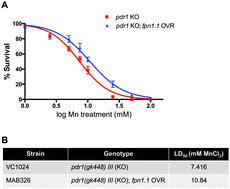Loss of pdr-1/parkin influences Mn homeostasis through altered ferroportin expression in C. elegans
Abstract
Overexposure to the essential metal manganese (Mn) can result in an irreversible condition known as manganism that shares similar pathophysiology with Parkinson's disease (PD), including dopaminergic (DAergic) cell loss that leads to motor and cognitive impairments. However, the mechanisms behind this neurotoxicity and its relationship with PD remain unclear. Many genes confer risk for autosomal recessive, early-onset PD, including the parkin/PARK2 gene that encodes for the E3 ubiquitin ligase Parkin. Using Caenorhabditis elegans (C. elegans) as an invertebrate model that conserves the DAergic system, we previously reported significantly increased Mn accumulation in pdr-1/parkin mutants compared to wildtype (WT) animals. For the current study, we hypothesize that this enhanced accumulation is due to alterations in Mn transport in the pdr-1 mutants. While no change in mRNA expression of the major Mn importer proteins (smf-1-3) was found in pdr-1 mutants, significant downregulation in mRNA levels of the putative Mn exporter ferroportin (fpn-1.1) was observed. Using a strain overexpressing fpn-1.1 in worms lacking pdr-1, we show evidence for attenuation of several endpoints of Mn-induced toxicity, including survival, metal accumulation, mitochondrial copy number and DAergic integrity, compared to pdr-1 mutants alone. These changes suggest a novel role of pdr-1 in modulating Mn export through altered transporter expression, and provides further support of metal dyshomeostasis as a component of Parkinsonism pathophysiology.


 Please wait while we load your content...
Please wait while we load your content...